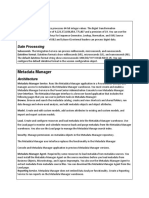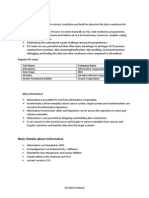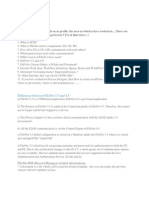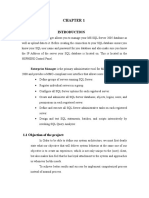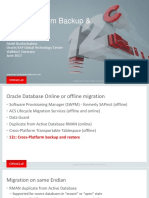Informatica 8
Informatica 8
Uploaded by
peruri64Copyright:
Available Formats
Informatica 8
Informatica 8
Uploaded by
peruri64Copyright
Available Formats
Share this document
Did you find this document useful?
Is this content inappropriate?
Copyright:
Available Formats
Informatica 8
Informatica 8
Uploaded by
peruri64Copyright:
Available Formats
Informatica 8.
x
PowerCenter 8.x components are 1. PowerCenter Domain 2. PowerCenter Repository3. Administration Console 4. PowerCenter Client 5. Repository Service 6. Integration Service PowerCenter Domain A domain is the primary unit for management and administration of services in PowerCenter. Components of a domain are Node, Service Manager and Application Services. Node Node is the logical representation of a machine in a domain. The machine in which the PowerCenter is installed acts as a Domain and also as a primary node. We can add other machines as nodes in the domain and configure the nodes to run application services such as the Integration Service or Repository Service. All service requests from other nodes in the domain go through the primary node also called as master gateway. The Service Manager The Service Manager runs on each node within a domain and is responsible for starting and running the application services. The Service Manager performs the following functions, >Alerts. Provides notifications of events like shutdowns, restart >Authentication. Authenticates user requests from the Administration Console, PowerCenter Client, Metadata Manager, and Data Analyzer >Domain configuration. Manages configuration details of the domain like machine name, port >Node configuration. Manages configuration details of a node metadata like machine name, port >Licensing. When an application service connects to the domain for the first time the licensing registration is performed and for subsequent connections the licensing information is verified >Logging. Manages the event logs from each service, the messages could be Fatal, Error, Warning, Info >User management. Manages users, groups, roles, and privileges Application services The services that essentially perform data movement, connect to different data sources and manage data are called Application services, they are namely Repository Service, Integration Service, Web Services Hub, SAPBW Service, Reporting Service and Metadata Manager Service. The application services run on each node based on the way we configure the node and the application service Domain Configuration Some of the configurations for a domain involves assigning host name, port numbers to the nodes, setting up Resilience Timeout values, providing connection information of metadata Database, SMTP details etc. All the Configuration information for a domain is stored in a set of relational database tables within the repository. Some of the global properties that are applicable for Application Services like Maximum Restart Attempts, Dispatch Mode as Round Robin/Metric Based/Adaptive
etc are configured under Domain Configuration 2. PowerCenter Repository The PowerCenter Repository is one of best metadata storage among all ETL products. The repository is sufficiently normalized to store metadata at a very detail level; which in turn means the Updates to therepository are very quick and the overall Team-based Development is smooth. The repository data structure is also useful for the users to do analysis and reporting. Accessibility to the repository through MX views and SDK kit extends the repositories capability from a simple storage of technical data to a database for analysis of the ETL metadata. PowerCenter Repository is a collection of 355 tables which can be created on any major relational database. The kinds of information that are stored in the repository are, 1. Repository configuration details 2. Mappings 3. Workflows 4. User Security 5. Process Data of session runs For a quick understanding, When a user creates a folder, corresponding entries are made into table OPB_SUBJECT; attributes like folder name, owner id, type of the folder like shared or not are all stored.When we create\import sources and define field names, datatypes etc in source analyzer entries are made into opb_src and OPB_SRC_FLD.When target and related fields are created/imported from any database entries are made into tables like OPB_TARG and OPB_TARG_FLD.Table OPB_MAPPING stores mapping attributes like Mapping Name, Folder Id, Valid status and mapping comments.Table OPB_WIDGET stores attributes like widget type, widget name, comments etc. Widgets are nothing but the Transformations which Informatica internally calls them as Widgets.Table OPB_SESSION stores configurations related to a session task and table OPB_CNX_ATTR stores information related to connection objects. Table OPB_WFLOW_RUN stores process details like workflow name, workflow started time, workflow completed time, server node it ran etc.REP_ALL_SOURCES, REP_ALL_TARGETS and REP_ALL_MAPPINGS are few of the many views created over these tables. PowerCenter applications access the PowerCenter repository through the Repository Service. The Repository Service protects metadata in the repository by managing repository connections and using object-locking to ensure object consistency. We can create a repository as global or local. We can go forglobal to store common objects that
multiple developers can use through shortcuts and go for local repository to perform of development mappings and workflows. From a local repository, we can create shortcuts to objects in shared folders in the global repository. PowerCenter supports versioning. A versioned repository can store multiple versions of an object. 3. Administration Console The Administration Console is a web application that we use to administer the PowerCenter domain and PowerCenter security. There are two pages in the console, Domain Page & Security Page.We can do the following In Domain Page: o Create & manage application services like Integration Service and Repository Service o Create and manage nodes, licenses and folders o Restart and shutdown nodes o View log events o Other domain management tasks like applying licenses and managing grids and resources We can do the following in Security Page: o Create, edit and delete native users and groups o Configure a connection to an LDAP directory service. Import users and groups from the LDAP directory service o Create, edit and delete Roles (Roles are collections of privileges) o Assign roles and privileges to users and groups o Create, edit, and delete operating system profiles. An operating system profile is a level of security that the Integration Services uses to run workflows 4. PowerCenter Client Designer, Workflow Manager, Workflow Monitor, Repository Manager & Data Stencil are five client tools that are used to design mappings, Mapplets, create sessions to load data and manage repository. Mapping is an ETL code pictorially depicting logical data flow from source to target involving transformations of the data. Designer is the tool to create mappings Designer has five window panes, Source Analyzer, Warehouse Designer, Transformation Developer, Mapping Designer and Mapplet Designer. Source Analyzer: Allows us to import Source table metadata from Relational databases, flat files, XML and COBOL files. We can only import the source definition in the source Analyzer and not the source data itself is to be understood. Source Analyzer also allows us to define our own Source data definition. Warehouse Designer: Allows us to import target table definitions which could be Relational databases, flat files, XML and COBOL files. We can also create target definitions manually and can group them into folders. There is an option to create the tables physically in the database that we do not have in source analyzer. Warehouse designer doesnt allow creating two tables with same name even if the columns names under them vary or they are from different
databases/schemas. Transformation Developer: Transformations like Filters, Lookups, Expressions etc that have scope to be re-used are developed in this pane. Alternatively Transformations developed in Mapping Designer can also be reused by checking the optionre-use and by that it would be displayed under Transformation Developer folders. Mapping Designer: This is the place where we actually depict our ETL process; we bring in source definitions, target definitions, transformations like filter, lookup, aggregate and develop a logical ETL program. In this place it is only a logical program because the actual data load can be done only by creating a session and workflow. Mapplet Designer: We create a set of transformations to be used and re-used across mappings. 5. Repository Service As we already discussed about metadata repository, now we discuss a separate,multi-threaded process that retrieves, inserts and updates metadata in the repository database tables, it is Repository Service. Repository service manages connections to the PowerCenter repository from PowerCenter client applications like Desinger, Workflow Manager, Monitor, Repository manager, console and integration service. Repository service is responsible for ensuring the consistency of metdata in the repository. Creation & Properties: Use the PowerCenter Administration Console Navigator window to create a Repository Service. The properties needed to create are, Service Name name of the service like rep_SalesPerformanceDev Location Domain and folder where the service is created License license service name Node, Primary Node & Backup Nodes Node on which the service process runs CodePage The Repository Service uses the character set encoded in the repository code page when writing data to the repository Database type & details Type of database, username, pwd, connect string and tablespacename The above properties are sufficient to create a repository service, however we can take a look at following features which are important for better performance and maintenance. General Properties > OperatingMode: Values are Normal and Exclusive. Use Exclusive mode to perform administrative tasks like enabling version control or promoting local to global repository > EnableVersionControl: Creates a versioned repository Node Assignments: High availability option is licensed feature which allows us to choose Primary & Backup nodes for continuous running of the repository service. Under normal licenses would see only only Node to select from Database Properties > DatabaseArrayOperationSize: Number of rows to fetch each time an array database operation is issued, such as insert or fetch. Default is 100 > DatabasePoolSize:Maximum number of connections to the repository database that the Repository Service can establish. If the Repository Service tries to establish more connections than specified for DatabasePoolSize, it times out the connection attempt after the number of seconds specified for DatabaseConnectionTimeout Advanced Properties > CommentsRequiredFor Checkin: Requires users to add comments when checking in repository
objects. > Error Severity Level: Level of error messages written to the Repository Service log. Specify one of the following message levels: Fatal, Error, Warning, Info, Trace & Debug > EnableRepAgentCaching:Enables repository agent caching. Repository agent caching provides optimal performance of the repository when you run workflows. When you enable repository agent caching, the Repository Service process caches metadata requested by the Integration Service. Default is Yes. > RACacheCapacity:Number of objects that the cache can contain when repository agent caching is enabled. You can increase the number of objects if there is available memory on the machine running the Repository Service process. The value must be between 100 and 10,000,000,000. Default is 10,000 > AllowWritesWithRACaching: Allows you to modify metadata in the repository when repository agent caching is enabled. When you allow writes, the Repository Service process flushes the cache each time you save metadata through the PowerCenter Client tools. You might want to disable writes to improve performance in a production environment where the Integration Service makes all changes to repository metadata. Default is Yes. Environment Variables The database client code page on a node is usually controlled by an environment variable. For example, Oracle uses NLS_LANG, and IBM DB2 uses DB2CODEPAGE. All Integration Services and Repository Services that run on this node use the same environment variable. You can configure a Repository Service process to use a different value for the database client code page environment variable than the value set for the node. You might want to configure the code page environment variable for a Repository Service process when the Repository Service process requires a different database client code page than the Integration Service process running on the same node. For example, the Integration Service reads from and writes to databases using the UTF-8 code page. The Integration Service requires that the code page environment variable be set to UTF-8. However, you have a Shift-JIS repository that requires that the code page environment variable be set to Shift-JIS. Set the environment variable on the node to UTF-8. Then add the environment variable to the Repository Service process properties and set the value to Shift-JIS. 6. Integration Service (IS) The key functions of IS are Interpretation of the workflow and mapping metadata from the repository. Execution of the instructions in the metadata Manages the data from source system to target system within the memory and disk The main three components of Integration Service which enable data movement are, Integration Service Process Load Balancer Data Transformation Manager 6.1 Integration Service Process (ISP) The Integration Service starts one or more Integration Service processes to run and monitor workflows. When we run a workflow, the ISP starts and locks the workflow, runs the workflow tasks, and starts the process to run sessions. The functions of the Integration Service Process are, Locks and reads the workflow Manages workflow scheduling, ie, maintains session dependency Reads the workflow parameter file Creates the workflow log
Runs workflow tasks and evaluates the conditional links Starts the DTM process to run the session Writes historical run information to the repository Sends post-session emails 6.2 Load Balancer The Load Balancer dispatches tasks to achieve optimal performance. It dispatches tasks to a single node or across the nodes in a grid after performing a sequence of steps. Before understanding these steps we have to know about Resources, Resource Provision Thresholds, Dispatch mode and Service levels Resources we can configure the Integration Service to check the resources available on each node and match them with the resources required to run the task. For example, if a session uses an SAP source, the Load Balancer dispatches the session only to nodes where the SAP client is installed Three Resource Provision Thresholds, The maximum number of runnable threads waiting for CPU resources on the node called Maximum CPU Run Queue Length. The maximum percentage of virtual memory allocated on the node relative to the total physical memory size called Maximum Memory %. The maximum number of running Session and Command tasks allowed for each Integration Service process running on the node called Maximum Processes Three Dispatch modes Round-Robin: The Load Balancer dispatches tasks to available nodes in a round-robin fashion after checking the Maximum Process threshold. Metric-based: Checks all the three resource provision thresholds and dispatches tasks in round robin fashion. Adaptive: Checks all the three resource provision thresholds and also ranks nodes according to current CPU availability Service Levels establishes priority among tasks that are waiting to be dispatched, the three components of service levels are Name, Dispatch Priority and Maximum dispatch wait time. Maximum dispatch wait time is the amount of time a task can wait in queue and this ensures no task waits forever A .Dispatching Tasks on a node 1. The Load Balancer checks different resource provision thresholds on the node depending on the Dispatch mode set. If dispatching the task causes any threshold to be exceeded, the Load Balancer places the task in the dispatch queue, and it dispatches the task later 2. The Load Balancer dispatches all tasks to the node that runs the master Integration Service process B. Dispatching Tasks on a grid, 1. The Load Balancer verifies which nodes are currently running and enabled 2. The Load Balancer identifies nodes that have the PowerCenter resources required by the tasks in the workflow 3. The Load Balancer verifies that the resource provision thresholds on each candidate node are not exceeded. If dispatching the task causes a threshold to be exceeded, the Load Balancer places the task in the dispatch queue, and it dispatches the task later 4. The Load Balancer selects a node based on the dispatch mode 6.3 Data Transformation Manager (DTM) Process When the workflow reaches a session, the Integration Service Process starts the DTM process. The DTM is the process associated with the session task. The DTM process performs the following tasks: Retrieves and validates session information from the repository. Validates source and target code pages. Verifies connection object permissions.
Performs pushdown optimization when the session is configured for pushdown optimization. Adds partitions to the session when the session is configured for dynamic partitioning. Expands the service process variables, session parameters, and mapping variables and parameters. Creates the session log. Runs pre-session shell commands, stored procedures, and SQL. Sends a request to start worker DTM processes on other nodes when the session is configured to run on a grid. Creates and runs mapping, reader, writer, and transformation threads to extract, transform, and load data Runs post-session stored procedures, SQL, and shell commands and sends post-session email After the session is complete, reports execution result to ISP Pictorial Representation of Workflow execution: 1. A PowerCenter Client request IS to start workflow 2. IS starts ISP 3. ISP consults LB to select node 4. ISP starts DTM in node selected by LB
You might also like
- InformaticalakshmiDocument15 pagesInformaticalakshmiMahidhar LeoNo ratings yet
- Dokumen - Tips - Informatica Power Center Notes 56b5a2c4ab853Document20 pagesDokumen - Tips - Informatica Power Center Notes 56b5a2c4ab853Lakshmi Prasanna ReddyNo ratings yet
- Informatica8.6 New FeaturesDocument5 pagesInformatica8.6 New FeaturesTulasi KonduruNo ratings yet
- Introduction To Informatica PowercenterDocument58 pagesIntroduction To Informatica Powercenterr.thogitiNo ratings yet
- SQL Server ArchitectureDocument13 pagesSQL Server ArchitectureMadhan MohanNo ratings yet
- Informatica Power Center 9.0.1: Informatica Reporting and Object Migration Part I Lab#36Document23 pagesInformatica Power Center 9.0.1: Informatica Reporting and Object Migration Part I Lab#36Amit Sharma100% (1)
- BODS Starter GuideDocument94 pagesBODS Starter GuideOwais KhokharNo ratings yet
- Repository OverviewDocument29 pagesRepository OverviewLaxmi ReddyNo ratings yet
- Informatica Power Center NOTESDocument15 pagesInformatica Power Center NOTESthilak501No ratings yet
- IDQ LearningDocument33 pagesIDQ LearningPradeep Kothakota0% (1)
- When Do You Go For Data Transfer Transformation: BenefitsDocument5 pagesWhen Do You Go For Data Transfer Transformation: BenefitsRamkoti VemulaNo ratings yet
- InformaticaDocument15 pagesInformaticakumar554No ratings yet
- Introduction To InformaticaDocument66 pagesIntroduction To InformaticaShravan KumarNo ratings yet
- Configuring An Oracle Business Intelligence Enterprise Edition Resource in Metadata Manager 8.6.1Document9 pagesConfiguring An Oracle Business Intelligence Enterprise Edition Resource in Metadata Manager 8.6.1MUKULNo ratings yet
- IDQ LearningDocument36 pagesIDQ LearningabcNo ratings yet
- IDQ LearningDocument33 pagesIDQ LearningabcNo ratings yet
- M.C.I.T.P L2 InterView QuestionsDocument8 pagesM.C.I.T.P L2 InterView QuestionsShaik Ashwaq JavedNo ratings yet
- Informatica FaqDocument19 pagesInformatica Faqappli1No ratings yet
- Etl Tool ComparisionDocument7 pagesEtl Tool ComparisionShravan KumarNo ratings yet
- Informatica Fundamentals 5Document16 pagesInformatica Fundamentals 5Ajay SinghNo ratings yet
- Tera Data 1222Document59 pagesTera Data 1222ravi90No ratings yet
- TransformationsDocument25 pagesTransformationsBharathNo ratings yet
- Notes InformaticaDocument121 pagesNotes InformaticaVijay Lolla100% (3)
- SsrsitDocument7 pagesSsrsitsaroj14decNo ratings yet
- BO Data Integrator Architecture: Designer, Repository & ServerDocument8 pagesBO Data Integrator Architecture: Designer, Repository & ServerNarender Reddy0% (1)
- Informatica PreviewDocument17 pagesInformatica PreviewPreeti SinghNo ratings yet
- BODS Interview QuestionsDocument5 pagesBODS Interview QuestionsRamesh ReddyNo ratings yet
- InformaticaDocument32 pagesInformaticaalphacom40% (1)
- A 9 New FeaturesDocument3 pagesA 9 New Featuresperuri64No ratings yet
- Unit-I: Oracle Product DetailDocument63 pagesUnit-I: Oracle Product DetailSaurabhNo ratings yet
- Informatic 8-Training-BISP PDFDocument271 pagesInformatic 8-Training-BISP PDFahmed_sftNo ratings yet
- Bods InterviewDocument61 pagesBods InterviewKishore Dammavalam100% (3)
- New 62Document2 pagesNew 62malleswari ChNo ratings yet
- A Interview Questions and Answers - Cool InterviewDocument30 pagesA Interview Questions and Answers - Cool Interviewcm_ram847118100% (16)
- Openreports-Install-Guide-1 0Document19 pagesOpenreports-Install-Guide-1 0george100% (2)
- Filenet TutorialsDocument15 pagesFilenet TutorialsGurram Rajesh Kumar100% (1)
- Informatica Interview Questioner Ambarish PDFDocument211 pagesInformatica Interview Questioner Ambarish PDFAjay SinghNo ratings yet
- Repo TableDocument2 pagesRepo TableVivek BansalNo ratings yet
- Informatica Powermart / Powercenter 8.6Document239 pagesInformatica Powermart / Powercenter 8.6DeepakNo ratings yet
- Informatica Powercenter 8.6: Basics Training CourseDocument197 pagesInformatica Powercenter 8.6: Basics Training CourseLuis CybergatoNo ratings yet
- Command Line Utilities in SSRS 2008Document8 pagesCommand Line Utilities in SSRS 2008rajesh.khannaNo ratings yet
- ETL Tools: Basic Details About InformaticaDocument121 pagesETL Tools: Basic Details About InformaticaL JanardanaNo ratings yet
- In For Ma Tic ADocument99 pagesIn For Ma Tic ASasikiran RaghupatruniNo ratings yet
- All in One Informatica QuestionnaireDocument83 pagesAll in One Informatica QuestionnaireRamasundari Vadali75% (4)
- Final - Database Enterprise ManagerDocument68 pagesFinal - Database Enterprise ManageromanfastsolutionNo ratings yet
- SAP Data ServicesDocument4 pagesSAP Data ServicesSuneelKumarUgginaNo ratings yet
- Final Spring Boot DocumentationDocument37 pagesFinal Spring Boot DocumentationArtiNo ratings yet
- BISP Informatica Question CollectionsDocument84 pagesBISP Informatica Question CollectionsAmit Sharma100% (2)
- Client Server ArchitectureDocument7 pagesClient Server ArchitectureBhuvi_rathodNo ratings yet
- Informatica Architecture SimpleDocument2 pagesInformatica Architecture SimpleJeeva RamasamyNo ratings yet
- Java / J2EE Interview Questions You'll Most Likely Be AskedFrom EverandJava / J2EE Interview Questions You'll Most Likely Be AskedNo ratings yet
- THE SQL LANGUAGE: Master Database Management and Unlock the Power of Data (2024 Beginner's Guide)From EverandTHE SQL LANGUAGE: Master Database Management and Unlock the Power of Data (2024 Beginner's Guide)No ratings yet
- Oracle Business Intelligence Enterprise Edition 12c - Second EditionFrom EverandOracle Business Intelligence Enterprise Edition 12c - Second EditionNo ratings yet
- List of SQL CommandsDocument18 pagesList of SQL CommandsSuraj BachhavNo ratings yet
- Rman: Cross-Platform Backup & Restore: Oracle Database 12c For SAPDocument26 pagesRman: Cross-Platform Backup & Restore: Oracle Database 12c For SAPalan theo100% (1)
- SQLQueries First Editon PDFDocument43 pagesSQLQueries First Editon PDFAlberto PuigdomenechNo ratings yet
- MongoDB Reference CardDocument28 pagesMongoDB Reference CardLuis ContrerasNo ratings yet
- Dashboard ExampleDocument9 pagesDashboard ExampleSamadNo ratings yet
- Semantica in MMDB PDFDocument551 pagesSemantica in MMDB PDFDeiu AndiNo ratings yet
- (Smtebooks - Com) Big Data Processing With Hadoop 1st EditionDocument255 pages(Smtebooks - Com) Big Data Processing With Hadoop 1st EditionNiamien Atta100% (1)
- Hw3 UpdatedDocument2 pagesHw3 UpdatedGeoffrey Liu0% (1)
- DBMS PPT Unit-5Document85 pagesDBMS PPT Unit-5mohisinashaik2005100% (1)
- CSC3064 Database Engineering: Entity-Relationship (E-R) ModelingDocument7 pagesCSC3064 Database Engineering: Entity-Relationship (E-R) ModelingHolly InSanestNo ratings yet
- Enterprise Application Characteristics: 3.1 Diverse ApplicationsDocument4 pagesEnterprise Application Characteristics: 3.1 Diverse ApplicationsAlexandru MoldovanNo ratings yet
- Update ActionsDocument3 pagesUpdate ActionsAnonymous mVsH2nNo ratings yet
- DBMSDocument61 pagesDBMSsangiwenmoyoNo ratings yet
- Ajp MSC Lab ManualDocument11 pagesAjp MSC Lab Manualjaganna14No ratings yet
- Informatica QnsDocument10 pagesInformatica QnssanguinerkNo ratings yet
- BAFBAN1 - Week 01, Presentation DeckDocument60 pagesBAFBAN1 - Week 01, Presentation DeckDeniary HiddlestonNo ratings yet
- Ernst and Farocki. Towards An Archive For Visual ConceptsDocument28 pagesErnst and Farocki. Towards An Archive For Visual ConceptsMiguel Ángel Maydana OchoaNo ratings yet
- OLAP Cube: 2 HierarchyDocument4 pagesOLAP Cube: 2 HierarchydavidarugueteNo ratings yet
- Data Loss PreventionDocument6 pagesData Loss Preventionrajesh kesariNo ratings yet
- Final Questions MCQDocument8 pagesFinal Questions MCQKarthik RamanNo ratings yet
- R01 1Document7 pagesR01 1vitig2No ratings yet
- Lesson 2 - Data Management and Data Management Book of Knowledge 010115Document73 pagesLesson 2 - Data Management and Data Management Book of Knowledge 010115Shantam50% (2)
- SAP BW 7.5 SP3, SAP HANA SP12, Design Studio v1.6: Noteworthy New Features & CapabilitiesDocument1 pageSAP BW 7.5 SP3, SAP HANA SP12, Design Studio v1.6: Noteworthy New Features & CapabilitiesMadhuMichelNo ratings yet
- Versant Database v.7.0.1.0 Administration ManualDocument465 pagesVersant Database v.7.0.1.0 Administration ManualdpnswNo ratings yet
- Conversion StepsDocument2 pagesConversion StepsasifsubhanNo ratings yet
- Top 100 Linux Interview QuestionsDocument8 pagesTop 100 Linux Interview Questionsvinod.nalawadeNo ratings yet
- Isilon GUI AdministrationDocument434 pagesIsilon GUI AdministrationRam GuggulNo ratings yet
- UT XII July 2023 Set 2 With AnswersDocument7 pagesUT XII July 2023 Set 2 With Answerslaxmi567No ratings yet
- SQL QueriesDocument10 pagesSQL QueriesSherin SnehaNo ratings yet
- 305 DOCUMENT - Merged - MergedDocument71 pages305 DOCUMENT - Merged - Mergedswathi reddyNo ratings yet


